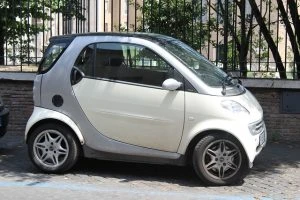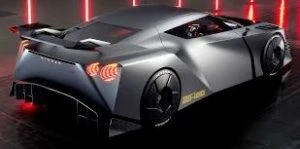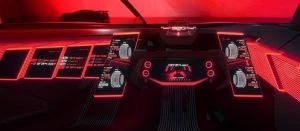automotive design
Talking Tyre Tech

Wheels, alloys, and tyres are pretty mesmerizing things. My mate’s dog thought they were biteable too, especially when moving. He did manage to learn, eventually, that this wasn’t the smartest thing to do, and rather spent his time running alongside the car to welcome visitors instead.
The wheel has been around for a wee while now, having first been thought to have been applied particularly well by the Sumerian people in 4000 BC, in the lower Mesopotamian regions, or what we know as modern-day Iraq. These folk inserted rotating axles into solid discs of wood to move objects from A to B. In 2000 BC, the discs began to be hollowed out to make a lighter wheel. Nowadays we use wheels for all sorts of applications, not least for rolling ourselves from Point A to Point B in cars.
I’m sure that the thought of using something soft for surrounding a wheel’s rim entered the mind of many an inventor or entrepreneur. However, in 1847, it was the Scottish inventor Robert Thomson who patented the first standard pneumatic tire. It wasn’t until 1888 that the first pneumatic tyre, made by John Dunlop (yes, as in Dunlop tyres), was able to be used as a practical application for bicycles. He found that rubber was able to withstand wear and tear and retain its resilience when being used as a bicycle tyre.
The tyre as we know it now has advanced tremendously in its science, physiology, and even application. Generally, a new tyre that we use on our cars today may contain up to 25 components and have as many as 12 different rubber compounds. Rubber still comes from the rubber tree (Ficus elastica), where the basic component (liquid latex) is extracted from the tree and coagulated with acid. It is then cleaned with water and pressed into bales, ready for all sorts of applications, including the tyre.
New developments in tyre technology have been rather underwhelming recently; that is, until Michelin’s latest invention. This exciting development by Michelin has potentially seen the pneumatic tyre being replaced by this new tyre technology. The new Michelin Uptis tyre technology utilizes a non-pneumatic tyre that relies on modern composites. The Michelin Uptis uses aluminium for the wheel, a combination of rubber for the tread, and a flexible load-bearing structure made from reinforced plastic with glass fibre that is used as the tyre’s substance for cushioning road imperfections on impact and coping with variable weight forces, while also maintaining the tyre’s rigidity when accelerating, braking, and cornering.
This ‘substance’ as we know it in a conventional tyre is known as compressed air and the tyre wall, which all work together to maintain grip and the tyre’s structural strength, and to soften road undulations. It is, however, prone to punctures. So, instead of simply air pressure providing the right mix of stiffness, flexibility, and durability, like on our conventional tyres, the new Michelin Uptis prototype tyre uses clever yet simple new technology that will even eliminate the hassle of having a puncture.

Michelin has recently said that this new tyre technology could also help reduce the cost of tyre replacement by up to 20%. Michelin’s Uptis tyre technology has and is being tested, having been fitted to 50 DHL delivery vans in Singapore last year.
Michelin Uptis tyres look pretty cool, too, because you can see right through the outer sidewall of the tyre to the other side and beyond, thanks to all the vacant spaces between the incredibly tough and elastic plastic pillars holding the integrity of the tyre together.
Kei Cars: The Little Cars That Can

In the Western world, cars seem to have been getting bigger. For example, my early 2000 Volvo S70, a generous sedan when it came out, is shorter than the more modern “little” hatchbacks in the supermarket car park beside it. However, this isn’t the case around the world. In Japan, congestion is a problem in busy cities such as Tokyo and Kyoto, so one of the solutions was to introduce what are known as kei cars, also known as compact cars. Some people call these K-cars, as this is approximately the way the word “kei” is pronounced.
The concept of kei cars isn’t new; in fact, the Japanese government introduced the general idea and legislation related to these vehicles in the late 1940s as part of the post-WWII recovery efforts. Back then, it was more about encouraging car ownership and stimulating the local automotive industry (and you can see for yourself how well that worked, given the number of Japanese makes on Australia’s roads). Today, however, it’s more about congestion and fuel consumption.
What is a kei car? As the Japanese name suggests (in full, it’s kei-jidōsha), it’s a small car. Specifically, it’s one that has restrictions on its size, both in terms of its dimensions and its engine displacement. To qualify as a kei car, an automobile has to be no taller than 2 metres, no wider than 1.45 metres and no longer than 3.4 metres. In terms of engine displacement, the maximum allowed is 660 cc. There’s no official limit on engine power, but it’s very unusual for a factory kei car to have more than 47 kW. Not that tuning and tweaking to get a bit more power is out of the question for those interested… Most of them are speed-limited to 140 km/h, which makes sense, given that these are designed for crowded city streets, not open road rural running. The width means that they don’t handle quite as well at high speeds, so that’s another reason why their top speed isn’t as high as what you’d find with the average Toyota Corolla.
Needless to say, electric kei cars are out there as well.
To encourage the adoption of kei cars, the Japanese government has a few incentives set up. If a car qualifies to have the distinctive yellow kei plates, it’s exempt from the need to buy parking space (apparently, to buy a car in Japan, you first have to buy street space to park it). Various on-road taxes are reduced with kei cars, as these taxes are based on things such as the engine displacement and the weight.
Now, we all know that where there are large numbers of people, there are houses to fix and goods to be transported, which require vans and trucks. Your typical kei car has the sort of cargo space that would suit a minimalist (Marie Kondo would love these, if she doesn’t already). However, kei vans and kei trucks are a thing – although we’d call latter kei utes, as they’re “pickup truck” rather than a miniature version of a big old Scania. The kei vans or microvans are allowed to be taller than the kei cars, which allows the to carry more of a load and has earned them the nickname of “miàn bāo chē” (meaning “bread loaf cars” in nearby China. The kei trucks have the same basic wheelbase but a cab-chassis layout.
Because of their low fuel consumption, suitability for urban settings, kei cars and their relatives are growing in popularity in other parts of the world outside Japan. Their general cuteness relates to another Japanese concept, namely the kawaii (cute) aesthetic. Although many customers in Australia are leery about very small cars, given that physics says that they’re not going to come off well in a collision with an SUV, some popular kei marks are found in the Aussie market. Do any of these sound familiar?
- Suzuki Alto
- Suzuki Jimny
- Misubishi i-Miev
- Smart ForTwo (this one is unusual, as it’s a kei car that’s not from a Japanese marque).
These are all “regular” cars that meet the criteria for kei cars that you can find down at your local dealer (which is why we have them in our reviews page). Plenty of people also arrange for private imports of popular kei cars such as various Daihatsu models, the stylish Honda Beat coupe convertible, the Suzuki Every van, the Toyota Copen sports car and the Subaru Sambar, just to name a few. There’s even a kei version of the Mitsubishi Pajero, the Pajero Mini.
The Nissan Hyper Force Concept Car

There would be little debate over whether a Nissan GT-R is a legendary supercar or not. It has been one of the most exciting cars of the last two to three decades, having even set a record on the Nürburgring racetrack of 7:08.68 min in 2013, which was achieved by the Nissan GT-R NISMO.
Recently, the Nissan Hyper Force concept car stunned the crowds at a car show in Japan. Could this concept potentially be the next new Nissan GT-R supercar?
The Nissan Hyper Force is an all-electric beast with a seriously brazen design suggesting time warp speeds! In the car’s layout is an application of some clever revolutionary solid-state batteries that enable the supercar’s output to power up to 985 kW. That’s almost 600 kW more than the current GT-R! It’s also good to see that solid-state batteries are starting to break out of the laboratory and into actual vehicles, as they have better safety performance. However, these solid-state batteries are inside something that’s got that little hit of adrenaline. This electric vehicle is electrifying.
With this level of output, the Nissan Hyper Force Concept car is carefully aerodynamically designed to ensure the air is pushed over the car to force it down on the road. In order to achieve the required levels of downforce, there are active winglets up the front end of the car to help channel air over the car, as well as a massive air scoop in the lower bumper, and an array of active fins for air manipulation. If you look at the back of the vehicle, the telltale twin LED taillight clusters are very typical of the Nissan Skyline GT-R. The massive wheel arches on the AWD machine look really spectacular, hiding what must be some serious rubber tyre profiles. If I were making a Batman movie, I’d cast this vehicle as the latest iteration of the Batmobile.

The doors open upwards and forwards in a gullwing-like action. Once the doors are opened, the onlookers are presented with a stunningly wild interior, featuring Lamborghini-crazy styling that is incredibly futuristic, offering sizzling red LED lighting vibes for high-speed driving modes. Gentler GT modes light up the interior in a blue colour. There are plenty of information displays and stylish graphics, as you’d expect. The interior styling continues the edgy, angular diagonal lines of the exterior, giving a Batmobile vibe. And did I see harness style seatbelts in there?

The Nissan Hyper Force concept was at the Japanese car show to inspire people, and to give them a taste of what a new roadgoing Nissan supercar (potentially GT-R) of the future might look like. This is seriously cool! Here’s hoping that we’ll see some of the ideas trickling down. I particularly like the idea of the ambient lighting changing with the driving style, so I hope that we see that one in upcoming Nissan models. I’d also like to see the harness-style seatbelts making their way into regular cars, though they’d take a bit of getting used to, especially for a women (but they could easily be an improvement over the three-pointers we’re used to).
Find out more and have a drool in the official promo video from Nissan:
Internet of Things (IoT) and the Australian Automotive Industry: what you need to know

The automotive industry is consistently evolving. And quite recently, one thing has revolutionised the way we drive: the Internet of Things (IoT).
While the IoT is a relatively new technology type, it has quickly become prominent and is now part of the everyday lives of people in Australia and beyond. If you’ve ever worn a smartwatch, used your phone to control your thermostat or created a shopping list on your smart refrigerator – all these are proof that the IoT is both popular and practical.
Naturally, this technological phenomenon is also reshaping the way vehicles of today are designed, manufactured, and driven.
So, in this article, we’ll explore what the IoT is, its role in the Australian automotive industry, its benefits and how this intersection is revolutionising the future of driving.
What is the Internet of Things (IoT)?
The Internet of Things (IoT) is the collective network of interconnected devices, vehicles, and other objects that share data and communicate over the Internet.
In IoT, devices are equipped with sensors, software, and connectivity features that allow them to collect and exchange information with other devices in the network without human intervention. Some of the most popular uses of the IoT are seen as wearable devices used to monitor health. It’s also used in smart home security systems and WiFi-enabled home appliances such as smart refrigerators and dishwashers.
In the automotive context, the use of IoT (also referred to as automotive IoT) can range from sensors in vehicles to traffic lights and even smart city infrastructure.
What are the applications of IoT in the automotive industry?
The impact of the Internet of Things on the Australian automotive industry is best observed in the following innovative advancements:
1. Connected cars are powered by automotive IoT.
IoT technology has enabled the rise of connected cars.
Connected cars are equipped with sensors that collect data about the
- vehicle’s performance,
- surroundings and
- driver behaviour.
This automotive data can then be communicated to service providers for:
- remote diagnostics,
- predictive maintenance and
- overall enhancement of the driving experience.
2. IoT is utilised in vehicle fleet management.
For businesses operating vehicle fleets, IoT provides real-time monitoring and management capabilities. It allows fleet managers to track the following:
- vehicle location,
- fuel consumption and
- vehicle health.
This way, routes and maintenance schedules can be optimised to streamline operations.
3. Smart traffic management is also possible with IoT.
IoT plays a crucial role in creating smart cities with intelligent traffic management systems. It enables traffic lights, road sensors, and cameras to communicate with vehicles, enhancing safety and improving traffic flow.
Cities like Singapore, London and Barcelona use this technology already.

What are the benefits of automotive IoT?
Automotive IoT is designed to improve the overall driving experience. It comes with several benefits, including:
Data-driven insights
The data collected by automotive IoT devices provides manufacturers with valuable insights they can use for predictive analytics and predictive maintenance. These insights can then be used to design better and safer vehicles, improve the manufacturing process and enhance customer experiences.
Enhanced road safety
Since automotive IoT technologies provide real-time data and alerts that can be used to assess risks of malfunction, they can help reduce road accidents and promote road safety.
Increased efficiency
With available data, manufacturers can improve the manufacturing process. Businesses with fleets can even use IoT technologies to improve operational efficiencies and reduce costs, while every single driver can benefit from increased accessibility with IoT.
While automotive IoT may still have some limitations, the ongoing advancements in automotive technology are opening up an exciting future where our vehicles can seamlessly integrate into a digital world.
Whether you’re headed on your dream adventure or just driving around running errands, it’s good to know that there are technologies that can make the driving experience more convenient and safer for everyone.
Find the right smart and connected vehicle for you with Private Fleet.
Private Fleet empowers you to gain all the benefits of a fleet purchase but as a private buyer.
Backed by decades of vehicle industry experience, fleet buying power and a network of car dealers across Australia, we’re here to ensure that buying your next vehicle will be as straightforward as possible while taking advantage of the latest technologies.
Shopping for a car is an enjoyable process – let us make it hassle-free, too.
Reach out to us today for a seamless and simple car-buying experience.